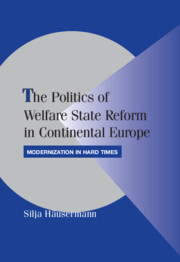Book contents
- Frontmatter
- Contents
- List of Figures
- List of Tables
- Preface
- The Politics of Welfare State Reform in Continental Europe
- 1 “EPPUR SI MUOVE”: WELFARE STATE CHANGE DESPITE INSTITUTIONAL INERTIA
- 2 MODERNIZATION IN HARD TIMES: THE POST-INDUSTRIAL POLITICS OF CONTINENTAL WELFARE STATE REFORM
- Part I Pension Reform in Continental Europe: A Framework of Analysis
- 3 A NEW REFORM AGENDA: OLD-AGE SECURITY IN THE POST-INDUSTRIAL ERA
- 4 CHANGING ALLIANCES: CONFLICT LINES AND ACTOR CONFIGURATIONS
- 5 REFORM OUTPUTS: STRATEGIES OF COALITIONAL ENGINEERING
- Part II Determinants of Successful Pension Reform in Continental Europe
- Appendices
- References
- Index
- Cambridge Studies in Comparative Politics
3 - A NEW REFORM AGENDA: OLD-AGE SECURITY IN THE POST-INDUSTRIAL ERA
Published online by Cambridge University Press: 06 July 2010
- Frontmatter
- Contents
- List of Figures
- List of Tables
- Preface
- The Politics of Welfare State Reform in Continental Europe
- 1 “EPPUR SI MUOVE”: WELFARE STATE CHANGE DESPITE INSTITUTIONAL INERTIA
- 2 MODERNIZATION IN HARD TIMES: THE POST-INDUSTRIAL POLITICS OF CONTINENTAL WELFARE STATE REFORM
- Part I Pension Reform in Continental Europe: A Framework of Analysis
- 3 A NEW REFORM AGENDA: OLD-AGE SECURITY IN THE POST-INDUSTRIAL ERA
- 4 CHANGING ALLIANCES: CONFLICT LINES AND ACTOR CONFIGURATIONS
- 5 REFORM OUTPUTS: STRATEGIES OF COALITIONAL ENGINEERING
- Part II Determinants of Successful Pension Reform in Continental Europe
- Appendices
- References
- Index
- Cambridge Studies in Comparative Politics
Summary
Both austerity and post-industrialization challenge all the major social policy schemes of the continental welfare states. Whether it is in labor market and unemployment policy, health-care provision, family policy, child and elderly care, poverty alleviation, or old-age security, there are serious threats to the long-term financial viability, and – simultaneously – challenges stemming from newly emerging social needs. However, each social policy scheme is affected by the same structural developments in a very specific way, and policy makers must thus react in an equally specific way. In labor market policy, for instance, the challenge consists in easing the structural adjustment of job markets under the constraint of financial austerity (on recent labor market and unemployment policy developments, see, e.g., Esping-Andersen and Regini 2000; Rueda 2005; Clasen and Clegg 2006; Clegg 2007), whereas health policy makers struggle to find a middle ground between the technologically feasible and the economically rational in a context of demographic aging (on recent health policy developments, see, e.g., Wendt and Thompson 2004; Hassenteufel and Palier 2007). In a similar vein, family and care policy is caught amid contradictory developments: there has been an explosion of care needs for both the elderly and children; an increase in women seeking paid work outside the home; and increasing poverty rates, especially among single mothers (on recent family policy developments, see, e.g., Jenson and Sineau 2001; Dienel 2002; Leitner, Ostner, and Schratzenstaller 2004).
- Type
- Chapter
- Information
- The Politics of Welfare State Reform in Continental EuropeModernization in Hard Times, pp. 33 - 55Publisher: Cambridge University PressPrint publication year: 2010

